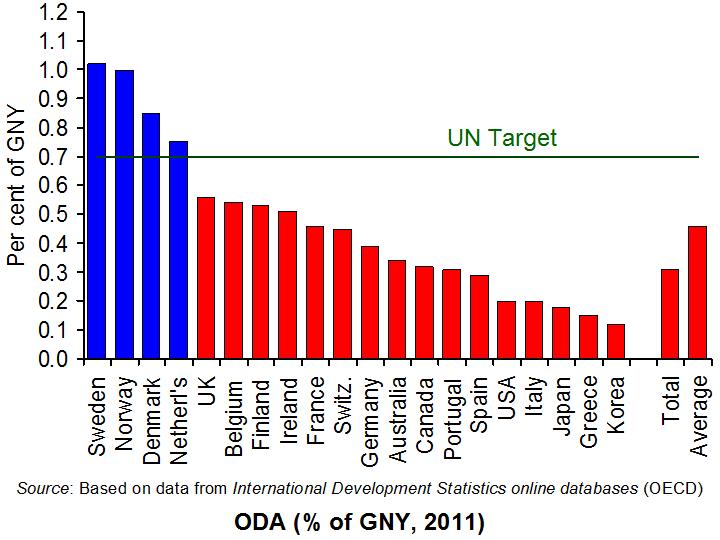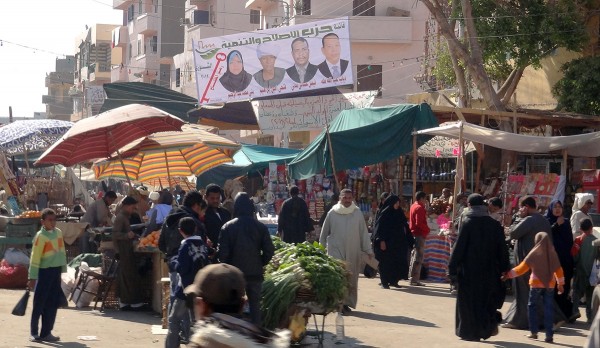 Many rich countries have made repeated commitments to the United Nations to give at least 0.7% of their gross national income (GNY) as international aid – or ‘official development assistance (ODA)’ as it is known. The first such commitments were made in 1970. Despite this, many of these countries’ aid to developing countries falls well short of the target.
Many rich countries have made repeated commitments to the United Nations to give at least 0.7% of their gross national income (GNY) as international aid – or ‘official development assistance (ODA)’ as it is known. The first such commitments were made in 1970. Despite this, many of these countries’ aid to developing countries falls well short of the target.
In fact the average amount given in aid in 2011 by the 23 donor countries which are members of the OECD’s Development Assistance Committee (DAC) was a mere 0.31% of GNY, with the USA, the biggest donor in absolute terms, giving only 0.2% of GNY. (Click here for a PowerPoint of the chart.) Since 2003, the DAC average has been 0.29% as compared with 0.30% between 1970 and 2002.
 In 2005, at the Gleneagles G8 summit, the 15 members of the EU which are Development Assistance Committee members committed themselves to reaching an ODA target of 0.51% of GNY in 2010 and to reach the 0.7% target by 2015. In 2011, the UK’s ODA/GNY ratio stood at 0.56% and so was above the EU target.
In 2005, at the Gleneagles G8 summit, the 15 members of the EU which are Development Assistance Committee members committed themselves to reaching an ODA target of 0.51% of GNY in 2010 and to reach the 0.7% target by 2015. In 2011, the UK’s ODA/GNY ratio stood at 0.56% and so was above the EU target.
Section 18 of the Coalition agreement pledges that the UK government will meet the 0.7% target by 2013 – a pledge initially made by the Labour government. So far, the government has stuck to this pledge and the aid budget has escaped cuts.
But with other parts of government expenditure facing cuts, pressure is mounting on the government to reduce the aid budget. There are two main parts to the argument. The first is that aid should face its ‘fair share’ of the cuts. The second is that aid is often an inefficient way of tackling poverty in developing countries and, when discussing aid, the focus should be on getting value for money rather than on the simple total amount of aid.
The following articles look at arguments for and against meeting aid targets and examine ways of making aid ‘smarter’.
Articles
Money may be tight, but ‘smart aid’ to developing countries can really work The Guardian, Larry Elliott (13/1/13)
International aid, but not as we know it The Guardian, Andy Sumner and Richard Mallett (31/12/12)
One in four support Britain’s foreign aid policies The Telegraph, Ben Leach (29/12/12)
Why is so much UK aid money still going to companies based in Britain? The Guardian, Claire Provost and Nicola Hughes (21/9/12)
Is the 0.7% aid target still relevant? The Guardian, Niels Keijzer (2/8/12)
What’s wrong with foreign aid? The Spectator (3/1/13)
Five reasons to deliver and legislate on international aid bond, UKAN (6/12)
The Political Economy of Bilateral Foreign Aid Working Knowledge, Harvard Business School, Eric D. Werker (4/1/13)
Misconceptions about aid Dawn (Pakistan), Niaz Murtaza (8/1/13)
Why political short-sightedness and randomised control trials can be a deadly mix for aid effectiveness Vox EU, Anders Olofsgård (13/10/12)
Aid in troubled times DfID, Paul Collier (2/7/12)
Data and information
Aid Effectiveness data World Bank
Aid statistics OECD
Aid effectiveness OECD
Aid Wikipedia
Questions
- What was agreed at the Gleneagles G8 summit?
- Examine the argument that aid crowds out private investment.
- Compare the relative benefits of tied and untied aid.
- Give some examples of ‘smart aid’.
- How would you establish whether or not it is ‘fair’ to cut the aid budget?
- Give three arguments for maintaining the aid budget and three arguments for cutting it. On which side do you come down and why?
The G20 countries meet each year. Normally their meetings are full of fine words resulting in little action. But at a summit in London on 2 April 2009, the fear of a deepening global recession focused minds and a package of measures worth over $1 trillion was agreed to stimulate trade and growth. This included $750 billion for the IMF to help economies in severe difficulties, $250 billion for financing world trade and $100 to multilateral development banks (such as the Asian Development Bank) to provide extra aid to the poorest countries.
The extra money for the IMF would include $500 billion of loans from member countries and £250 billion in new money – a form of international quantitative easing. This new money would be in the form of ‘special drawing rights’. These are denominated in dollars and are created by the IMF to be drawn on by countries in difficulties.
There was also agreement to tighten financial regulation and to resist protectionism. A ‘Financial Stability Board’ would be set up and work with the IMF to design a strengthened regulatory system for banks and other financial institutions and for financial markets and instruments.
The following articles look at the agreement and its likely effects.
‘This is the day the world came together to fight back’ Independent (2/4/09)
G20 communiqué: Point by point analysis Telegraph (2/4/09)
G20 summit – leaders’ statement. Full text of the communiqué Guardian (2/4/09)
G20: Economic summit snapshot BBC News Online (2/4/09)
G20 leaders seal $1tn global deal BBC News Online (2/4/09)
G-force The Economist (2/4/09)
World leaders declare war on risk Sydney Morning Herald (3/4/09)
Postscript (Sept 2009)
G20: What progress has been made? BBC News (23/9/09)
G20: Pledge by pledge BBC News (25/9/09)
Questions
- What will determine the success or failure of the G20 agreement to revive the world economy?
- Identify any multiplier effects from the agreed measures.
- Why did the French and German governments object to any further fiscal stimulus packages?
“10 million children die each year from preventable, poverty-related diseases; there are 1.4 billion people in the world surviving on less than $1.25 a day; and more than 70 million primary school-age children are out of school”. The Millennium Development Goals were targets set by the developed world to try to improve this situation by 2015. However, although world leaders met in September 2008 to renew their commitments to meeting these goals, the financial crisis has drawn attention away from these issues and focused most governments on narrower, domestic goals.
Women are key to fighting poverty BBC News Online (23/9/08)
A stagnant promise Guardian (24/9/08)
Questions
- Summarise the Millennium Development Goals (MDGs) and the progress that has been achieved towards meeting them.
- Assess the policies that have been adopted by developed countries to try to achieve the MDGs. Are they the most appropriate way to achieve these ends?
- Discuss whether the financial crisis has made it more difficult to achieve the targets set out by the MDGs.
At the turn of the century, the UN Development Programme identified a series of seven Millennium Development Goals (http://www.undp.org/mdg/). The article linked to below from the Guardian, considers the progress that has been made towards these goals. Urgent progress is required if the goals are to be met by the target date of 2015.
Poverty, hunger and disease: so much done yet so much left to do Guardian (10/12/07)
Questions
| 1. |
What are the seven Millennium Development Goals. |
| 2. |
Discuss the action that is required if the goals are to be met by the target date of 2015. |
| 3. |
Analyse the extent to which an increase in overseas aid will help to achieve the Millennium Development Goals. |
In many parts of the world poor water and sanitation are one of the biggest killers. The article below looks at the situation in the shanty towns of Dhaka in Bangladesh.
Where death by water is part of daily life Guardian (26/11/07)
Questions
| 1. |
What is the difference between economic growth and economic development. |
| 2. |
Assess the extent to which an increase in economic growth will help to deliver higher living standards. |
| 3. |
Discuss the effectiveness of foreign aid as a policy to improve the standard of water and sanitation. |
 Many rich countries have made repeated commitments to the United Nations to give at least 0.7% of their gross national income (GNY) as international aid – or ‘official development assistance (ODA)’ as it is known. The first such commitments were made in 1970. Despite this, many of these countries’ aid to developing countries falls well short of the target.
Many rich countries have made repeated commitments to the United Nations to give at least 0.7% of their gross national income (GNY) as international aid – or ‘official development assistance (ODA)’ as it is known. The first such commitments were made in 1970. Despite this, many of these countries’ aid to developing countries falls well short of the target. In 2005, at the Gleneagles G8 summit, the 15 members of the EU which are Development Assistance Committee members committed themselves to reaching an ODA target of 0.51% of GNY in 2010 and to reach the 0.7% target by 2015. In 2011, the UK’s ODA/GNY ratio stood at 0.56% and so was above the EU target.
In 2005, at the Gleneagles G8 summit, the 15 members of the EU which are Development Assistance Committee members committed themselves to reaching an ODA target of 0.51% of GNY in 2010 and to reach the 0.7% target by 2015. In 2011, the UK’s ODA/GNY ratio stood at 0.56% and so was above the EU target.